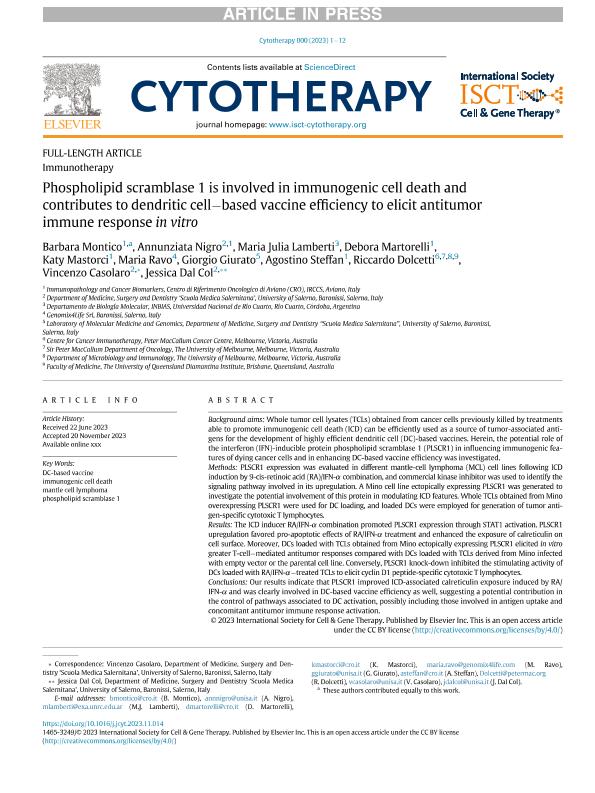Mostrar el registro sencillo del ítem
dc.contributor.author
Montico, Barbara
dc.contributor.author
Nigro, Annunziata
dc.contributor.author
Lamberti, María Julia

dc.contributor.author
Martorelli, Debora
dc.contributor.author
Mastorci, Katy
dc.contributor.author
Ravo, Maria
dc.contributor.author
Giurato, Giorgio
dc.contributor.author
Steffan, Agostino
dc.contributor.author
Dolcetti, Riccardo
dc.contributor.author
Casolaro, Vincenzo
dc.contributor.author
Dal Col, Jessica
dc.date.available
2024-02-15T11:46:04Z
dc.date.issued
2023-12
dc.identifier.citation
Montico, Barbara; Nigro, Annunziata; Lamberti, María Julia; Martorelli, Debora; Mastorci, Katy; et al.; Phospholipid scramblase 1 is involved in immunogenic cell death and contributes to dendritic cell–based vaccine efficiency to elicit antitumor immune response in vitro; Taylor & Francis As; Cytotherapy; 26; 2; 12-2023; 145-156
dc.identifier.issn
1465-3249
dc.identifier.uri
http://hdl.handle.net/11336/227002
dc.description.abstract
Background aims: Whole tumor cell lysates (TCLs) obtained from cancer cells previously killed by treatments able to promote immunogenic cell death (ICD) can be efficiently used as a source of tumor-associated antigens for the development of highly efficient dendritic cell (DC)-based vaccines. Herein, the potential role of the interferon (IFN)-inducible protein phospholipid scramblase 1 (PLSCR1) in influencing immunogenic features of dying cancer cells and in enhancing DC-based vaccine efficiency was investigated. Methods: PLSCR1 expression was evaluated in different mantle-cell lymphoma (MCL) cell lines following ICD induction by 9-cis-retinoic acid (RA)/IFN-α combination, and commercial kinase inhibitor was used to identify the signaling pathway involved in its upregulation. A Mino cell line ectopically expressing PLSCR1 was generated to investigate the potential involvement of this protein in modulating ICD features. Whole TCLs obtained from Mino overexpressing PLSCR1 were used for DC loading, and loaded DCs were employed for generation of tumor antigen-specific cytotoxic T lymphocytes. Results: The ICD inducer RA/IFN-α combination promoted PLSCR1 expression through STAT1 activation. PLSCR1 upregulation favored pro-apoptotic effects of RA/IFN-α treatment and enhanced the exposure of calreticulin on cell surface. Moreover, DCs loaded with TCLs obtained from Mino ectopically expressing PLSCR1 elicited in vitro greater T-cell–mediated antitumor responses compared with DCs loaded with TCLs derived from Mino infected with empty vector or the parental cell line. Conversely, PLSCR1 knock-down inhibited the stimulating activity of DCs loaded with RA/IFN-α–treated TCLs to elicit cyclin D1 peptide-specific cytotoxic T lymphocytes. Conclusions: Our results indicate that PLSCR1 improved ICD-associated calreticulin exposure induced by RA/IFN-α and was clearly involved in DC-based vaccine efficiency as well, suggesting a potential contribution in the control of pathways associated to DC activation, possibly including those involved in antigen uptake and concomitant antitumor immune response activation.
dc.format
application/pdf
dc.language.iso
eng
dc.publisher
Taylor & Francis As

dc.rights
info:eu-repo/semantics/openAccess
dc.rights.uri
https://creativecommons.org/licenses/by/2.5/ar/
dc.subject
DC-BASED VACCINE
dc.subject
IMMUNOGENIC CELL DEATH
dc.subject
MANTLE CELL LYMPHOMA
dc.subject
PHOSPHOLIPID SCRAMBLASE 1
dc.subject.classification
Inmunología

dc.subject.classification
Medicina Básica

dc.subject.classification
CIENCIAS MÉDICAS Y DE LA SALUD

dc.title
Phospholipid scramblase 1 is involved in immunogenic cell death and contributes to dendritic cell–based vaccine efficiency to elicit antitumor immune response in vitro
dc.type
info:eu-repo/semantics/article
dc.type
info:ar-repo/semantics/artículo
dc.type
info:eu-repo/semantics/publishedVersion
dc.date.updated
2024-02-14T11:45:13Z
dc.journal.volume
26
dc.journal.number
2
dc.journal.pagination
145-156
dc.journal.pais
Reino Unido

dc.journal.ciudad
Londres
dc.description.fil
Fil: Montico, Barbara. Centro Di Riferimento Oncologico Di Aviano; Italia. Istituti di Ricovero e Cura a Carattere Scientifico; Italia
dc.description.fil
Fil: Nigro, Annunziata. Universita di Salerno; Italia
dc.description.fil
Fil: Lamberti, María Julia. Universidad Nacional de Rio Cuarto. Facultad de Cs.exactas Fisicoquimicas y Naturales. Instituto de Biotecnologia Ambiental y Salud. - Consejo Nacional de Investigaciones Cientificas y Tecnicas. Centro Cientifico Tecnologico Conicet - Cordoba. Instituto de Biotecnologia Ambiental y Salud.; Argentina. Universidad Nacional de Río Cuarto; Argentina
dc.description.fil
Fil: Martorelli, Debora. Centro Di Riferimento Oncologico Di Aviano; Italia. Istituti di Ricovero e Cura a Carattere Scientifico; Italia
dc.description.fil
Fil: Mastorci, Katy. Centro Di Riferimento Oncologico Di Aviano; Italia. Istituti di Ricovero e Cura a Carattere Scientifico; Italia
dc.description.fil
Fil: Ravo, Maria. Genomix 4 Life; Italia
dc.description.fil
Fil: Giurato, Giorgio. Universita di Salerno; Italia
dc.description.fil
Fil: Steffan, Agostino. Centro Di Riferimento Oncologico Di Aviano; Italia. Istituti di Ricovero e Cura a Carattere Scientifico; Italia
dc.description.fil
Fil: Dolcetti, Riccardo. University of Melbourne; Australia
dc.description.fil
Fil: Casolaro, Vincenzo. Universita di Salerno; Italia
dc.description.fil
Fil: Dal Col, Jessica. Universita di Salerno; Italia
dc.journal.title
Cytotherapy

dc.relation.alternativeid
info:eu-repo/semantics/altIdentifier/doi/http://dx.doi.org/10.1016/j.jcyt.2023.11.014
dc.relation.alternativeid
info:eu-repo/semantics/altIdentifier/url/https://www.sciencedirect.com/science/article/pii/S1465324923011271
Archivos asociados
